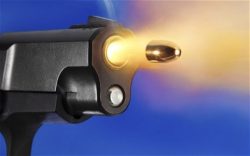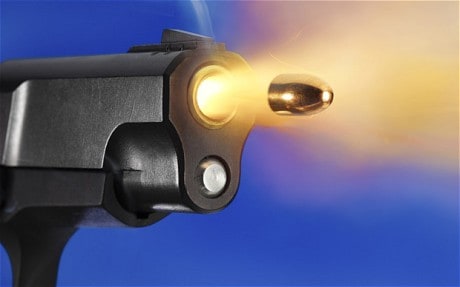 No one prays to get shot, but you have to know what happens in the human body after being shot and ways you could survive it. You never can tell when you will need this information!
No one prays to get shot, but you have to know what happens in the human body after being shot and ways you could survive it. You never can tell when you will need this information!
If you’re afraid of being shot, you’re not alone, and your fears are, unfortunately, justified.
This is what happens if you take a bullet, and what you can do to possibly save your life or someone else’s.
What a Bullet Does to Your Body
By now, you probably know that a bullet can punch its way into the human body pretty well. After all, there’s a reason gun haven’t changed a whole lot in the last several hundred years: they’re effective. But beyond the obvious hole a bullet makes in your flesh, there’s a lot more damage happening on the inside.
For starters, when a bullet enters your body, your flesh absorbs a great deal of the momentum the bullet was carrying. A 9mm bullet, which is typically fired from handguns used for self-defense and by police, travels at a speed of about 900 mph. All that momentum has to go somewhere, so the bullet transfers it to your body, causing it to expand and create a large cavity, then falling back in on itself. That tremor can cause serious damage to your organs and tissues, even if the bullet doesn’t actually hit them.
After the bullet tears into your flesh, fate rolls the dice. It’s possible to survive being shot, multiple times even, but it largely comes down to the path those bullets take. Connor Narciso, former combat medic and Army Green Beret who served in Afghanistan, says don’t let movies and TV fool you. A single gunshot in the arm or leg is more than enough to kill you if you’re unlucky.
ICYMI: 3 bad brushing habits you must stop
Why? Blood loss, which Narciso asserts is the number one preventable cause of death on the battlefield (about 90% of those preventable deaths are due to blood loss). If that bullet hits a brachial artery in your arm, one of the bilateral inguinal arteries in your groin, or the subclavian arteries beneath each of your clavicles, you’re looking at massive hemorrhaging. Your muscles do have some built-in defense mechanisms to try and stop it some, but it’s usually not enough when you have internal blood loss caused by penetrating projectiles like bullets. They cut through arteries and veins without alerting your muscles to the danger. Basically, the movie myth of non-fatal “flesh wounds” is more than far-fetched, according to Narciso, and soldiers and police are never trained to disarm in this way.
The other danger, of course, is organ damage that leads to organ failure. If a bullet strikes a vital organ, it will tear through it the same way it did with your outer flesh. Furthermore, bullets can bounce, ricochet, and change direction once they’re inside you, meaning one bullet can strike multiple organs. There’s no knowing where a bullet will go once it’s been fired at you. That said, it’s absolutely possible to survive being shot if the bullet happens to miss all of your vital areas. It’s even possible if you’re shot many times at once—just ask rapper 50 Cent. It’s not about how many there are, it’s about where they go.
What about bulletproof materials like kevlar, you ask? It can certainly stop bullets from penetrating your flesh, reducing a lot of the internal damage, but you still have to deal with stopping the bullet’s momentum. Think of the bullet as a soccer ball, and the kevlar—as well as your flesh behind it—being the net. You’re not really stopping the bullet per se, you’re watching it, and that can still do plenty of damage. Plus, kevlar is only useful for smaller caliber rounds like you’d find in most handguns. Rifle rounds will go right through it. You’ll need military-grade ceramic body armor for those.
What You Can Do If You or Someone Around You Is Shot
As stated, surviving a gunshot largely comes down to luck. Still, there are a few things you can do to increase your odds of survival. How does it feel when it happens? Personal accounts range anywhere from an “intense burning sensation” to “getting beaned by a pitch in baseball.” I once spoke with a girl that was accidentally shot in her shoulder at a party, and she said it was like being shoved really hard, followed by intense, sharp pain after a minute or two. Of course, many victims say the worst part is feeling their own warm blood pour all over their body. In short, it’s not fun.
When you realize you or another person has been shot, call 911. You need to get medical professionals on the spot as soon as possible. After that, Narciso says you need to try and stop the bleeding. Remember, blood loss is what kills most people in this instance. So, look for swelling, skin discoloration, and other signs of hemorrhaging, then try to control it by applying manual pressure on the wound, or by fastening a tourniquet high and tight on the limb where the wound is located.
If there’s an open bullet wound in the chest cavity, it’s important that you try to prevent any air getting sucked into it. Otherwise, you or the victim may suffer tension pneumothorax, or a collapsed lung, cutting breathing capability in half. The best way to plug the hole is with some form of occlusive dressing. This can be petrolatum, gauze from a first aid kit, or something improvised, like tape or plastic. Whatever you use, it needs to provide a total seal, so absorbent materials like standard gauze pads will not work. At this point, you have to wait and pray until emergency personnel arrives.
Culled from lifehacker.com

